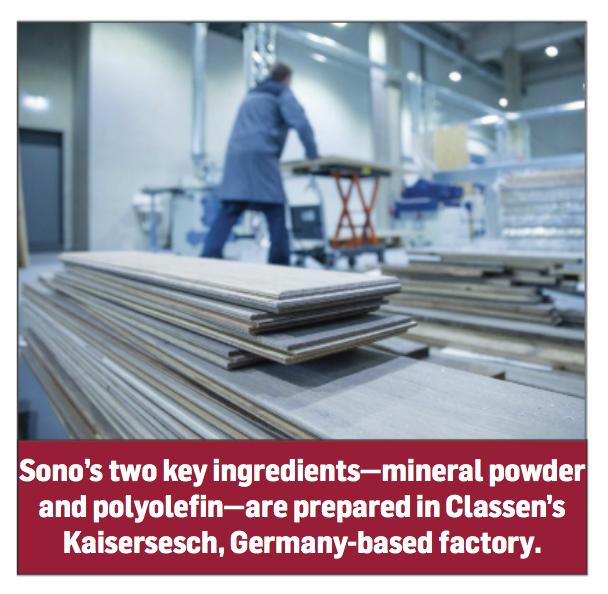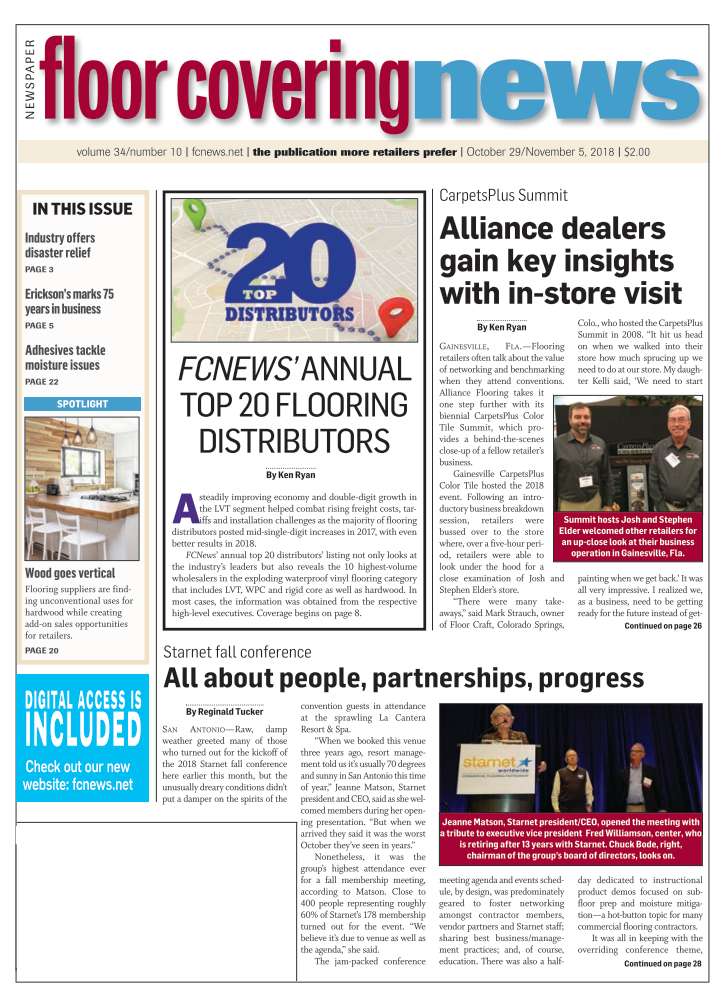October 29/November 5, 2018: Volume 34, Issue 10
By Lindsay Baillie
 It has been more than a year since Inhaus launched Sono—the company’s 100% recyclable, PVC-free flooring. Made up of 60% mineral powder and 40% polypropylene, Sono is waterproof, easy to install and highly stable under both humidity and heat, according to the company. What’s more, the company continues to invest in its digital printing to ensure quality, on-trend visuals.
It has been more than a year since Inhaus launched Sono—the company’s 100% recyclable, PVC-free flooring. Made up of 60% mineral powder and 40% polypropylene, Sono is waterproof, easy to install and highly stable under both humidity and heat, according to the company. What’s more, the company continues to invest in its digital printing to ensure quality, on-trend visuals.
All this has not been lost on the company’s distributor partners. “Inhaus’ Sono has been a great introduction for Hughes Western Sales,” said Zack Cone, the distributor’s vice president, marketing. “The product has given us something to offer in our market that is significantly different from any other rigid products that are available. Due to the ceramic composite core we have a product that gives us the ability to install in colder weather and offer a larger installation square footage than any other product available in this category. We love the direct-to-core digital printing, which gives us better visuals and allows us to offer a higher-than-normal, unique plank repeat.”
Scott Rozmus, president and CEO, FlorStar Sales, also lauds the product’s attributes. “Sono is an exciting product because it is unlike any other. German-made and featuring a ceramic-based core while also being PVC free, it is a wonderful extension of our Inhaus laminate collection. Aside from being very environmentally friendly, the product’s ceramic roots mean that it is essentially inert. Neither heat nor moisture impact its performance. That has proven to be a winning combination.”
Inhaus’ latest innovation starts at Classen’s manufacturing facility in Kaisersesch, Germany. The building, which is fully automated, produces Sono using patented Ceramin technology—a one-step manufacturing process that produces a homogenous product where the core is formed with mineral powder and polyolefin. Unlike other manufacturing facilities that use chemicals to create products, Classen’s production plant uses low-pressure heat to create the finished core.
“Sono is fundamentally a different product,” Derek Welbourn, CEO, Inhaus, told FCNews staff during a tour of the factory. “No one has ever done this before.”
Behind the curtain
The development of Sono starts with the preparation of the product’s two primary ingredients—mineral powder and polyolefin. Both materials are sourced from Europe and are medical grade, according to Welbourn. To ensure top-quality products, the raw materials are tested in a lab every hour.
Daniel Lang, vice president sales and marketing, Inhaus, reiterated Sono’s inert attributes. “Heat doesn’t affect it; water doesn’t affect it. Furthermore, because of the great ingredients, it’s not a vinyl [product]. The way you cure this product makes it more like a tile. It’s harder than a plastic or vinyl. However, it’s not as hard as a tile because it is still flexible.”
Next the boards are developed on a double-bed press, where the company can produce different sizes and lengths. The boards’ visuals are then digitally printed in high definition directly to the core, followed by the application of a UV-cured, clear acrylic lacquer that highlights the digital print, according to Welbourn. During the printing process, ink is also used to create texture on the boards.
Another noteworthy feature: The facility contains eight rows of printing heads with 19 heads in each row. Each printer head has about 900 openings which help create a sharp visual. “They are so accurate that when they print it’s scary,” Lang said. The facility also produces its own unique designs for each visual. Sono is available in 26 colors—22 wood visuals and four stone looks.
After the visuals have been applied, the boards enter the profiling section of the facility where tongue and groove are added to the product. Sono features Classen’s MegaLoc locking system, which allows installers to click the product together.
The end result is an extremely durable product that’s good looking as well. “You can put this product in the shower,” Lang said. “We can install [loose lay] up to 10,000 square feet without having to worry about transitions. And with a glue-down installation, you don’t have to worry about heat at all.”
Not one to rest on its laurels, Inhaus is eyeing future applications for the product. “We are better to the core—that’s our motto,” Lang explained. “What we want to do is take care of the whole concept—walls and floors.”

